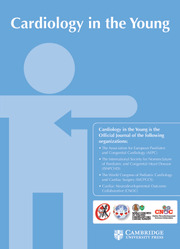No CrossRef data available.
Article contents
Ascending-to-descending aortic grafting: an alternative approach for adults with complex aortic coarctation
Published online by Cambridge University Press: 22 September 2025
Abstract
Contemporary management of aortic coarctation in adults is primarily by percutaneous intervention; however, this is not always possible. Intrapericardial ascending-to-descending aortic grafting is an alternative approach in adults with complex aortic coarctation. It can be performed off-pump and allows for a simultaneous treatment of concomitant cardiac lesions. Our aim was to examine the indications and the clinical long-term outcomes of intrapericardial ascending-to-descending aortic grafting in adults with aortic coarctation.
We retrospectively reviewed demographic, clinical, surgical, and follow-up data of patients who underwent intrapericardial ascending-to-descending aortic grafting at a single tertiary centre between September 1994 and November 2016.
Ten patients were identified. Indications were primary intervention (n = 4), re-coarctation (n = 5), and iatrogenic coarctation of aorta after stent grafting (n = 1). There were no peri-operative deaths. During a mean follow-up of 13.6 ± 9.4 years, one patient died 11 years after surgery, unrelated to intrapericardial ascending-to-descending aortic grafting. All grafts remained patent with no anastomotic pseudoaneurysms at latest follow-up.
The mean systolic blood pressure decreased from 154 ± 24 mmHg at baseline to 134 ± 20 mmHg at latest follow-up (p = 0.05), with the mean number of prescribed antihypertensive medications decreasing from 2.8 ± 1.5 preoperatively to 1.6 ± 0.5 (p = 0.11).
Intrapericardial ascending-to-descending aortic grafting is a safe and effective approach for adults with complex coarctation of aorta or re-coarctation not suitable for a percutaneous or conventional surgical approach. Improved blood pressure control and reduced anti-hypertensive use were observed long-term.
Information
- Type
- Original Article
- Information
- Copyright
- © The Author(s), 2025. Published by Cambridge University Press


